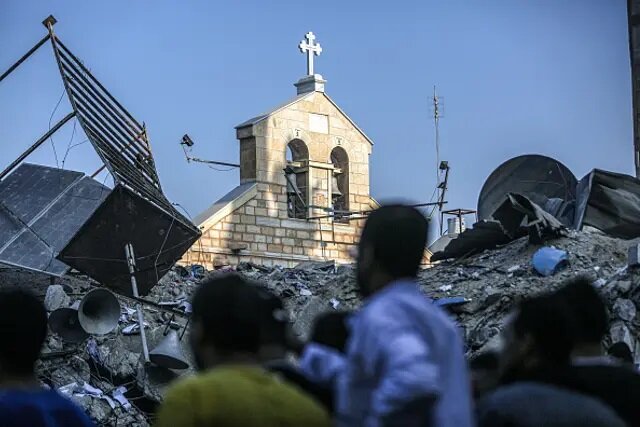Gaza’s cultural gems at great risk

Israel’s constant actions in Gaza provide enough evidence to conclude that the Zionist regime is committing atrocities intended to kill innocent civilians.
Apart from a serious and imminent risk of genocide across the Palestinian enclave with a long list of evidence including examples of mass killings of ordinary people in public places or their homes, the regime is eliminating Gaza’s rich cultural heritage in tandem.
To cite an example, Saint Porphyrius, which is one of the oldest-standing churches in the world, was severely hit on October 19 by an Israeli air strike that left dozens dead and injured at the Greek Orthodox place of worship. Witnesses told AFP the assault hurt the exterior of the 12th-century place of worship and caused nearby buildings to collapse.
The church is named after a 5th-century bishop of Gaza, Bishop Porphyrius, who allegedly closed all pagan temples in Gaza and erected the church’s original foundations in c. 425 CE.
The story of Gaza’s heritage sites is a stark reminder of the toll that war takes on both people and their cultural heritage.Saint Porphyrius is just meters away from al-Ahli Arab hospital, which suffered a tragic attack on October 17. It claimed the lives of 471 people and wounded 314 others, according to Palestinian officials. The hospital assumed historical status as one of the oldest operating hospitals. It was founded in 1882, according to the Jerusalem diocese’s website.
The destruction of these heritage sites is not only a loss for the people of Gaza but for the world as a whole. These sites are a testament to the rich history and culture of the region, and their destruction is a tragedy that cannot be undone.
Gaza Strip is home to several important heritage sites, including St Hilarion Monastery, Al Omari Mosque, Anthedon Harbour, Qasr Al Basha Hammam Al Sammara, and several other churches built over the centuries from the late Roman era to the Umayyad epoch.
Here are glimpses of those cultural gems that are at risk of complete destruction:
St Hilarion Monastery is famed as the strip’s oldest and largest known Christian monument, which is allegedly named after the founder of Palestinian monasticism, about 300 CE.
Al Omari Mosque, aka the Great Mosque of Gaza, is one of the oldest in the strip, which is still in use for daily prayers. Narratives say, the mosque was originally a temple, then it turned into a Byzantine church, and ultimately repurposed into a masjid following the Muslim conquest of Gaza in the 7th century.
Anthedon Harbour, the first known seaport of Gaza, was inhabited from 800 BC to 1100 CE as a cultural melting pot from Babylonians through to the early Islamic rules of the Umayyad and Fatimid empires.
Qasr Al Basha, also known as Napoleon’s Fort, has a romantic legend down to the 13th century when the Mamluk Sultan Zaher Baibars came to Gaza several times as a soldier fighting the Crusaders and Mongols in Syria. Legend has it that the fort served as home for one of his wives, whom he met in Gaza.
Hammam Al Sammara is a Turkish-style public bath house that was mainly used by Gaza’s Samaritan community. Although rumored to date back to pre-Islamic times in Gaza, the bathhouse (Hammam) dates back to 1320 CE, according to an inscription installed on the ancient structure. Theodore Edward Dowling his 1913 writings suggested that in 1584, a Samaritan community existed in Gaza and possessed a large synagogue and two bathhouses.
The story of Gaza’s heritage sites is a stark reminder of the toll that war takes on both people and their cultural heritage. It is up to all of us to work towards a future where such destruction is no longer a reality.
AFM
Leave a Comment